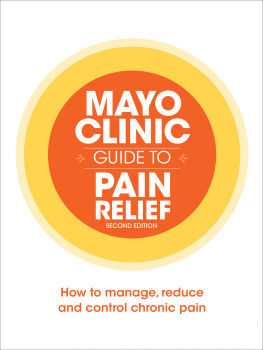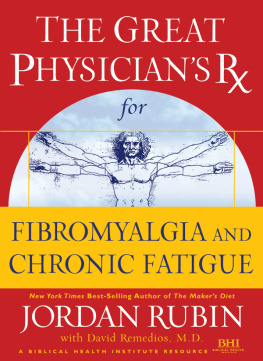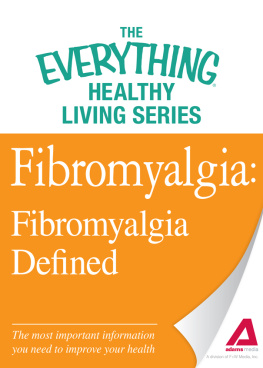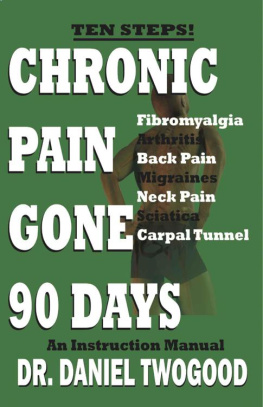WHEN MUSCLE PAIN WONT GO AWAY
WHEN
MUSCLE PAIN
WONT GO
AWAY
3rd Edition
The Relief Handbook for Fibromyalgia
and Chronic Muscle Pain
by
Gayle Backstrom
with
Dr. Bernard Rubin
Professor of Medicine
University of North Texas
Health Science Center of Texas
at Fort Worth

The information in this book is not meant to be a substitute for consulting with your physician. See your doctor for your healthcare needs.
Copyright 1992, 1995, 1998 Gayle Backstrom
All rights reserved.
No part of this book may be reproduced in any form or by any means without written permission from the publisher.
Published by Taylor Publishing Company
1550 West Mockingbird Lane
Dallas, Texas 75235
Illustrations by David Hunter unless otherwise noted.
Library of Congress Cataloging-in-Publication Data
Backstrom, Gayle.
When muscle pain wont go away: the relief handbook for fibromyalgia and chronic muscle pain / by Gayle Backstrom with Bernard Rubin.3rd ed.
p. cm.
Includes bibliographical references.
ISBN 0-87833-998-1
1. Fibromyalgia. 2. Myalgia. I. Rubin, Bernard R. II. Title.
RC927.3.B33 1998 |
616.7'4dc21 | 987860 |
CIP |
Printed in the United States of America
10 9 8 7 6 5 4 3 2
To
Judith Rosen and Carol Yager
and to all of the
Support Group Leaders
who give so much of themselves
in spite of their own fibromyalgia
so that others may learn more about FM
Acknowledgments
I would like to thank Judith Rosen and Carol Yager of Dallas, Support Group Leaders for the Dallas Fibromyalgia Support Group for all of their help in sharing their notes from several conferences that they attended and I could not, plus for all of their kind words and thoughts. I would also like to thank my agent, Jim Donovan. He believed in my book enough to buy it when he was an editor at Taylor Publishing and later, believed enough in me to take me on as a client when he formed his own literary agency. Jason Rath has worked with me on this third edition and I want to thank him for all of his help. Also Camille Cline, my current editor who stepped in to see the book to print. I also appreciate the great work by Carol Trammel, the art director at Taylor, for making the book look reader friendly; and thanks also to Michelle Justiss.
I would like to thank Brenda Napier and other members of the Fibromyalgia Association of Greater Washington; Rae Marie Gleason of the National Fibromyalgia Research Association of Salem, Oregon; and Mary Anne Saathoff, RN, BSN, of the Fibromyalgia Alliance of America, Columbus, Ohio, for their help in sharing information and for all of the hard work they and other members of their associations do, not only in helping increase awareness of fibromyalgia but also for their efforts in funding research.
I want to thank my sister, Phyllis Knox, who helped in typing for this edition; David Hunter for his illustrations; and Justin Harden, who not only is my massage therapist, but who also kindly helped with some typing of the Positive Tips. I would like to thank everyone who sent me their Positive Tips for Living with Fibromyalgia (noted in shaded boxes throughout book). I have always tried to think in positive terms and these individuals willingly shared their own tips with me and all readers of this book.
Again, it has been friends who supported and encouraged me through the research and revisions, but this time, I also had my sister, Phyllis, and her daughter and son-in-law, Tammie and Ben Reyes with their two daughters, Ashley and Brianna, who have been there for me. (Ashley thinks I never eat or sleep or do anything except sit at the computer.) Thanks also to friends Donna Bell, Joy Wright, Linda Erickson, Billie Cantwell and, of course, Maurine Burnett, along with a couple of new friends, Teri Burgoon and Sharon Humpert, who carried my load at the Denton Citizens Police Academy Alumni Association while I worked on this.
Contents
Introduction
As so many people do when trying to set a time frame to their life, I mark time as before and after, specifically, before my major flare-up in 1986-87 and after. That is only natural when a particular event has had such a tremendous impact upon a life. In 1987 after a five-week hospital stay and then subsequently having to give up my full time work, I faced my future with a lot of uncertainty and fear. I was experiencing almost constant high levels of pain and exhaustion which kept me from not only pursuing a career but also any leisure activities that demanded much energymake that even mild energy. I felt that I stood on the brink of a deep chasm with what I considered a normal life on the other side and no bridge in sight.
By the time I wrote the first edition of When Muscle Pain Wont Go Away, I had begun to build my own bridge. It was slow work but not lonely work. Dr. Bernard Rubin contributed a great deal of solid timber to help form the basic structure. That timber was not in the form of a cure for my fibromyalgia, there was no cure then, and there still isnt one today, YET. But what Dr. Rubin gave me was the gift of a caring, knowledgeable doctor who believed in me and who gave me the beginnings of understanding about fibromyalgia.
He encouraged me, not only as a patient to educate myself about FM but also as a writer to pass the knowledge that I gained on to others. By nature, I am a nosy person, always trying to learn more about a wide range of subjects. In writing this book, I had a legitimate reason to dig deep into all of the areas that I was facing with a chronic illness as puzzling and frustrating as fibromyalgia. So I gathered knowledge and used it to form the major supports of my new bridge. Because I not only had to research the subject, but also digest it as much as possible and then turn around and explain it to an audience of others who also had FM, I believe that I gained even more understanding than I might have if it were only for me.
I have had quite a number of others helping me in building the bridge which is in actuality, my learning how to live with FM. There have been psychologists, some that I saw long before I realized the full impact of FM, others I saw along the way. There were physical therapists, occupational therapists, nurses, and massage therapists who helped me physically and mentally. There were friends who have stood by me, one who saved my life, and others who have taught me that it is okay to accept help when I needed it.
There are close spiritual friends whose faith has shored up mine when I faltered and doubted in my ability to accept the changes in my life. There are both volunteers and police officers from the Denton Police Department who accept that I have something to give despite the limitations of time and energy.
Perhaps one of the biggest surprises was the responses I have received because of this book. Each letter thanking me for writing the book and telling me how it has helped has provided more links to the walkway of my bridge, giving me solid support to walk on.
Now just over eleven years after I left my last full time job and as I write this third edition to the book, I realize that my bridge is still being built. Oh, I have made a great deal of progress on it and at first glance, it seems to be a solid structure. In other words, I often feel as if I know all I need to about living with FM, at least for me, personally. And yet, each day, I learn something new, not just the medical information which I researched to go into this edition but the practical, day-to-day aspects of life.
Next page








